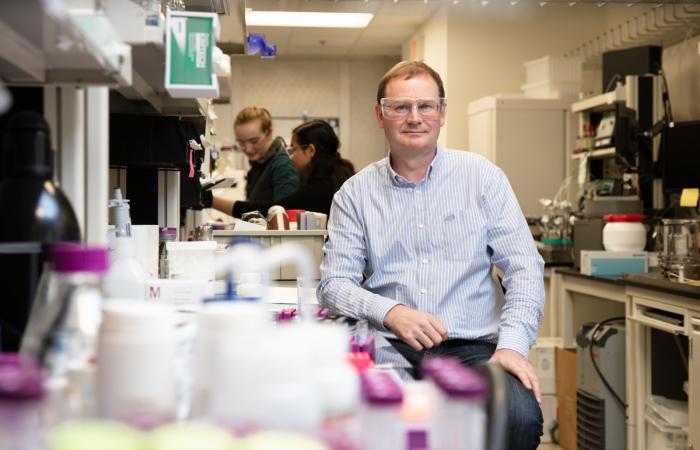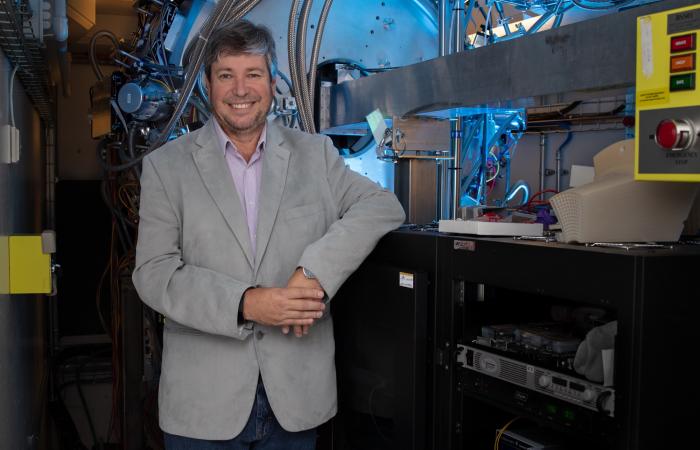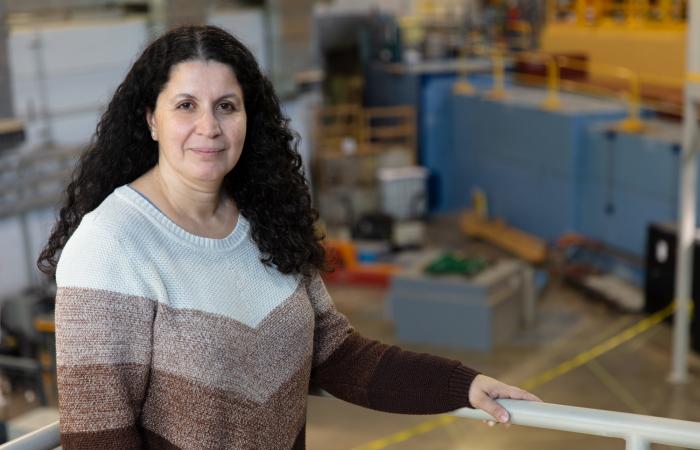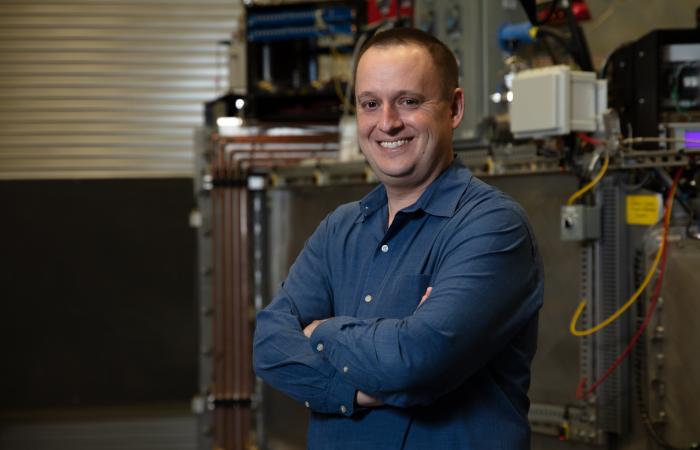If you take a material and place it in a beam of neutrons—one of two particles in the nucleus of an atom—you can get information that is unavailable any other way. Neutrons allow scientists to analyze materials that are difficult to see with techniques like X-rays and electron beams, and they’re particularly useful for studying phenomena related to lighter elements in the presence of heavier ones.
Neutrons have contributed a great deal to our understanding of the universe and natural phenomena, although we've known about them for less than nine decades. In fact, as late as the beginning of the 20th century, scientists had no real idea what atoms looked like.
The discovery of the neutron, physicists’ understanding of how neutrons can be used as a scientific tool, and the establishment of facilities that put that knowledge to use are central to ORNL’s history and to the laboratory’s identity today.
Neutrons unlock the secrets of matter
The suggestion that the world was made of atoms had been around nearly two and a half millennia, since the time of the Greek philosopher Democritus in the fifth century B.C., but it was pretty much ignored. Plato, in fact, was so unimpressed with Democritus that he wanted the man's books burned.
The idea of the atom sat dormant for more than 2,000 years, until the early 1800s, when English scientist John Dalton for the first time offered up an atomic theory based on experiment and observation. For Dalton, atoms were like hard little balls and were the fundamental building blocks of nature.
His theory sat unchanged for the better part of a century, until English physicist J. J. Thomson discovered the electron in 1897, thereby opening the possibility that atoms were made up of even smaller parts.
Noting that these tiny, negatively charged particles, which Thomson called "corpuscles," had a mass 2,000 times less than that of the lightest atom—hydrogen—and that atoms as a whole had no net electrical charge, either positive or negative, Thompson suggested that atoms comprise clouds of positive charge throughout which the negatively charged electrons are scattered. This was known as the plum pudding model because it reminded people of the bits of fruit scattered throughout that popular English dish.
The idea that atoms have a solid nucleus came in 1911 from New Zealand-born physicist Ernest Rutherford, who would eventually be known as the father of nuclear physics. When two of Rutherford's students—including Hans Geiger, co-inventor of the Geiger counter—shot positively charged alpha particles at a thin gold foil, a few deflected off the foil, suggesting that a gold atom has a small, dense center. So much for the plum pudding model.
A few years later, Rutherford showed that the hydrogen nucleus—which we now know is a single proton—was found in the nuclei of other elements. As a result, we can credit him with discovering the proton.
At this point, scientists understood that an atom's nucleus contained protons, which gave the nucleus its positive charge, but it also needed to contain something else to explain why the mass of most atoms is greater than their atomic number—which we now know is equal to the number of protons in the nucleus. The most common explanation was that the nucleus contained both protons and electrons—the two subatomic particles known at the time—with the negatively charged electrons canceling out some of the positive charge of the protons.
It was British physicist James Chadwick—a student of Rutherford’s—who determined that the added mass was due to a third atomic particle, which he called a neutron. In 1932, Chadwick announced his findings in a letter to the journal Nature, titled "Possible Existence of a Neutron." He followed up a few months later with an article in the Proceedings of the Royal Society titled "The Existence of a Neutron."
What makes neutrons special
Neutrons, then, are one of three components of an atom, the others being electrons and protons. (Physicists later discovered that protons and neutrons are made up of even smaller particles called quarks.)
Like all subatomic particles, neutrons follow the laws of quantum mechanics, exhibiting the properties of both particles and waves. Their usefulness depends largely on their wavelengths, which researchers can manipulate by slowing them down to varying degrees. For instance, neutrons with energies characteristic of room-temperature water are known as thermal neutrons and have wavelengths of about 2 angstroms, or close to the distance between atoms.
Neutrons also have magnetic moments, which effectively make them into tiny subatomic magnets. Because of this, neutrons can be used to explore the magnetic properties of materials responsible for technological advances from hard drives to MRI machines.
Neutrons and the bomb
Neutrons can also cause atoms—or technically their nuclei—to split, a process called nuclear fission. That discovery—made by chemists Otto Hahn and Fritz Strassman and confirmed by Lise Meitner and Otto Frisch—took place in a Germany that had already been taken over by the Nazi dictatorship.
The potential for nuclear fission to release massive amounts of energy in a chain reaction soon had scientists looking for ways to develop a weapon of unprecedented power. Chadwick—the neutron's discoverer—joined in the United Kingdom's effort to develop nuclear weapons and, when the U.K. and United States agreed to collaborate on the project, worked with his American counterparts in the Manhattan Project.
Another scientist involved in the Manhattan Project was Ernest Wollan. Wollan was in attendance when the first manmade nuclear reactor—named Chicago Pile-1—went critical below a football field at the University of Chicago in December 1942. He was also on hand when the first continuously operating nuclear reactor went critical the following November in Oak Ridge.
That reactor, located at what would become ORNL, was known at the time as the Clinton Pile and eventually as the X-10 Graphite Reactor.
Neutron science is born at ORNL
Working with the Manhattan Project as a pioneer in the new field of health physics, Wollan measured radiation exposure and developed the film badge dosimeter, but he was also excited by the research possibilities opened up by the new technology (see “What makes neutron scattering unique,” page 10). Wollan had a background in X-ray physics, and he wanted to use neutrons in a similar way to unlock the structure of materials.
In May 1944, he asked for and was granted permission to use neutrons produced by the reactor to study the diffraction of neutrons in a single crystal. Using an X-ray diffractometer brought from the University of Chicago and retrofitted at the X-10 Graphite Reactor to become the world's first neutron scattering instrument, Wollan and chemist Lyle Benjamin Borst used neutron diffraction to study crystals of gypsum and sodium chloride, producing a plot known as a "rocking curve."
Their work drew the attention of physicist Clifford Shull, who joined Wollan at Oak Ridge in 1946. The two developed neutron diffraction methods for determining the atomic structure of materials.
Within the next decade, Wollan and Shull worked out how neutrons interact with elements and their isotopes and measured scattering patterns from a wide range of materials. Their achievements included the first neutron radiograph, the first direct evidence of antiferromagnetism (in which the magnetic moments of neighboring atoms point in opposite directions), and the first use of neutrons to determine the structure of hydrogen-containing compounds.
For their pioneering work, Shull received a share of the 1994 Nobel Prize in Physics. Wollan, unfortunately, would not share in that prize because he died in 1984.
Neutron sources beyond the Graphite Reactor
ORNL continued its neutron research in 1958 with construction of the Oak Ridge Research Reactor, which produced beams of neutrons 100 times as intense as those created by the Graphite Reactor.
Then, in 1965, the lab's High Flux Isotope Reactor went into operation. HFIR's primary purpose was to produce radioactive isotopes for medicine, research and industry, but ORNL Director Alvin Weinberg ensured it would continue the lab's work in neutron research, insisting that four beam tubes be installed to transport neutrons from the reactor's core for use in more advanced scattering experiments.
HFIR has been going strong for 50-plus years, with no end in sight. Along the way, it has provided important insights into materials such as high-temperature superconductors, rare earth metals and graphite, and has allowed researchers to explore many biological and technological systems.
Adding an accelerator-based neutron source
While nuclear reactors are an important source of neutrons, they are not the only one. Particle accelerators can also be used to produce neutrons, by slamming charged particles into heavy metal targets. This process—known as spallation—is the basis for ORNL's Spallation Neutron Source, which was completed in 2006.
SNS and HFIR make ORNL a destination for neutron researchers worldwide. SNS provides the world's most intense pulsed neutron beams, while HFIR provides one of the highest rates of continuous-beam neutrons of any research reactor in the world.
Between them, they provide powerful tools for analyzing materials, giving researchers the ability to study magnetic behavior, living systems such as cells and plants, and compounds containing both light and heavy elements.
“Neutrons are essential because they can see how atoms move within matter,” explained Paul Langan, ORNL's associate laboratory director for neutron sciences, “and they can easily see very light atoms like hydrogen and lithium and sodium that are nearly invisible to other techniques.”
Neutron scattering: The next generation
Researchers need intense neutron beams to carry out their experiments. The more powerful the beam, the more information can be gleaned from it.
While SNS is already a world leader in neutron scattering, plans are under way to take it to the next level. These plans include both an upgrade to the facility's accelerator, making it more powerful, and a new target station focused on providing longer-wavelength neutrons (see “SNS upgrades will benefit researchers,” page 12).
The power upgrade will take the accelerator from 1.4 to 2.8 megawatts, thereby providing more neutrons and enabling more experiments with smaller samples.
“The proton power upgrade will make some experiments faster on the first target station,” said ORNL physicist Ken Herwig. “It'll mean that we can look at somewhat smaller samples more readily than we could before and do harder experiments. And having more neutrons means measurements that we can do today can be made more quickly, letting us observe changes in samples with better time resolution.”
It also means that SNS can add a Second Target Station that provides a wider range of neutrons and is optimized to produce “cold” neutrons with longer wavelengths. By providing that wider range of neutrons, the new target station will allow researchers to examine materials at different scales, from the atomic up 10,000-fold to the mesoscopic scale.
“The First Target Station still will be the neutron source of choice for looking at the structure of materials with atomic resolution or fast dynamics in materials,” Langan said. “The Second Target Station will be the source for looking at very complex materials when excellent resolution is needed over a wide range of length or time scales. The High Flux Isotope Reactor still will be the source for looking at materials when detailed measurements in a specific narrow range of length or time scales are required.
“So all three sources are best matched for looking at different scientific problems, and together they really cover everything. It will be unparalleled capabilities for U.S. researchers.”





